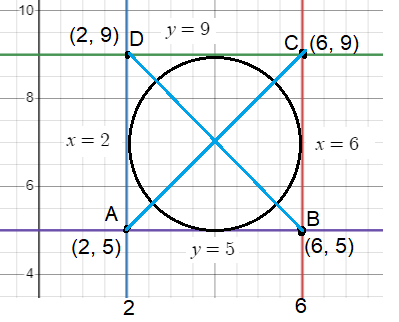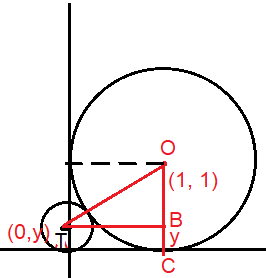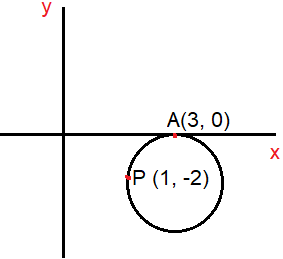PROBLEM SOLVING IN CIRCLE CONIC SECTIONS
Problem 1 :
The center of the circle inscribed in a square formed by the lines x2 - 8x + 12 = 0 and y2 - 14y + 45 = 0 is
a) (4, 7) b) (7, 4) c) (9, 4) d) (4, 9)
Solution :
x2 - 8x + 12 = 0 and y2 - 14y + 45 = 0
Solving equations, we get
(x - 6)(x - 2) = 0 and (y - 9)(y - 5) = 0
x = 6, x = 2 and y = 9, y = 5

By plotting the points and figuring out the midpoint of AC, we will get center of the circle.
Midpoint of AC = (2 + 6)/2, (5 + 9)/2
= 8/2, 14/2
= (4, 7)
So, center of the circle is (4, 7).
Problem 2 :
The equation of the normal to the circle x2 + y2 - 2x - 2y + 1 = 0 which is parallel to the line 2x + 4y = 3 is
a) x + 2y = 3 b) x + 2y + 3 = 0
c) 2x + 4y + 3 = 0 d) x - 2y + 3 = 0
Solution :
x2 + y2 - 2x - 2y + 1 = 0
2g = -2, g = -1
2f = -2, f = -1
Center (-g, -f) ==> (1, 1) and radius = √g2 + f2 - c
radius = √12 + 12 - 1 ==> 1
The normal is parallel to the given line and it will pass through the center of the circle.
2x + 4y = 3
Slope of the normal drawn to the circle :
m = -1/2
will pass through the point (1, 1)
y - y1= m(x - x1)
y - 1= (-1/2)(x - 1)
2y - 2 = -1(x - 1)
2y - 2 = -x + 1
x + 2y - 2 - 1 = 0
x + 2y - 3 = 0
x + 2y = 3
Problem 3 :
The radius of the circle is passing through the point (6, 2) two of whose diameters are x + y = 6 and x + 2y = 4 is
a) 10 b) 2√5 c) 6 d) 4
Solution :
Diameters will intersect each other at center.
x + y = 6 ------(1)
x + 2y = 4 ------(2)
(1) - (2)
y - 2y = 6 - 4
-y = 2
y = -2
Applying the value of y in (1)
x - 2 = 6
x = 8
Center of the circle is (8, -2)
Equation of the circle :
(x - h)2 + (y - k)2 = r2
(x - 8)2 + (y + 2)2 = r2
It passes through the point (6, 2).
(6 - 8)2 + (2 + 2)2 = r2
(-2)2 + 42 = r2
r2 = 4 + 16
r2 = 20
r = √20
r = 2√5
Problem 4 :
The equation of the circle passing through the foci of the ellipse
having center at (0, 3) is
a) x2 + y2 - 6y - 7 = 0 b) x2 + y2 - 6y + 7 = 0
c) x2 + y2 - 6y - 5 = 0 d) x2 + y2 - 6y + 5 = 0
Solution :
From the given equation of ellipse, we know that it must be symmetric about x-axis.
Distance between center and foci of the ellipse. Center of the circle and foci of the ellipse lie on the same horizontal line.
Equation of the circle :
(x - h)2 + (y - k)2 = r2
(x - 0)2 + (y - 3)2 = 42
x2 + y2 -6y + 9 = 16
x2 + y2 - 6y + 9 - 16 = 0
x2 + y2 - 6y - 7 = 0
Problem 5 :
Let C be the circle with center at (1, 1) and radius = 1. If T is the circle centered at (0, y) passing through the origin and touching the circle C externally, then the radius of T is equal to
a) √3/√2 b) √3/2 c) 1/2 d) 1/4
Solution :

In triangle TOB, OB = 1 - y, TB = 1, TO = y + 1
So, the radius of the circle T is 1/4.
Problem 6 :
If the coordinates at one end of a diameter of the circle
x2 + y2 - 8x - 4y + c = 0
are (11, 2) the coordinates of the other end are
a) (-5, 2) b) (-3, 2) c) (5, -2) d) (-2, 5)
Solution :
x2 + y2 - 8x - 4y + c = 0
Finding center of the circle :
2g = -8, g = -4
2f = -4, f = -2
(-g, -f) ==> (4, 2)
Distance between center and one end of the diameter = distance between center and other end of the diameter
(or)
Midpoint of the endpoints of the diameter = center
Let (a, b) be the other endpoint of the diameter.
(11 + a)/2, (2 + b)/2 = (4, 2)
|
(11 + a)/2 = 4 11 + a = 8 a = 8 - 11 a = -3 |
(2 + b)/2 = 2 2 + b = 4 b = 4 - 2 b = 2 |
So, the other endpoint is (-3, 2).
Problem 6 :
The circle passing through (1, -2) and touching the axis of x at (3, 0) passing through the point
a) (-5, 2) b) (2, -5) c) (5, -2) d) (-2, 5)
Solution :

Center will be in the form of (3, -k)
(x - h)2 + (y - k)2 = r2
(x - 3)2 + (y + k)2 = r2 ---(1)
The circle is passing through the points (1, -2) and (3, 0)
Applying the point (3, 0), we get
(3 - 3)2 + (0 - k)2 = r2
(0 - k)2 = r2
k2 = r2
k = r
Applying the point (1, -2), we get
(1 - 3)2 + (-2 - r)2 = r2
4 + 4 + 4r + r2 = r2
4r = -8
r = -2 then k = -2
Center (3, -k) ==>(3, 2)
Applying the value of r in (1), we get
(x - 3)2 + (y - k)2 = (-2)2
(x - 3)2 + (y + 2)2 = 4
|
Option a : (-5, 2) (x - 3)2 + (y + 2)2 = 4 does not satisfy |
Option b : (2, -5) (2 - 3)2 + (-5 + 2)2 = 4 does not satisfy |
Option c :
(5, -2)
(5 - 3)2 + (-2 + 2)2 = 4
Satisfies. So, option c is correct.
Recent Articles
-
Finding Range of Values Inequality Problems
May 21, 24 08:51 PM
Finding Range of Values Inequality Problems -
Solving Two Step Inequality Word Problems
May 21, 24 08:51 AM
Solving Two Step Inequality Word Problems -
Exponential Function Context and Data Modeling
May 20, 24 10:45 PM
Exponential Function Context and Data Modeling